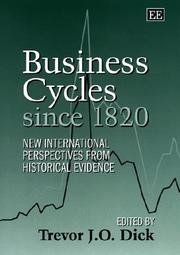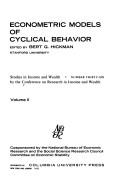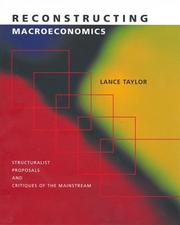| Listing 1 - 5 of 5 |
Sort by
|

ISBN: 1858983509 Year: 1998 Publisher: Cheltenham Edward Elgar
Abstract | Keywords | Export | Availability | Bookmark
 Loading...
Loading...Choose an application
- Reference Manager
- EndNote
- RefWorks (Direct export to RefWorks)
Business cycles --- anno 1900-1999 --- anno 1800-1899 --- Business cycles. --- AA / International- internationaal --- 304.4 --- 331.05 --- 331.00 --- 304.2 --- 338.542 --- Economic cycles --- Economic fluctuations --- Cycles --- Financial crises --- Cyclische veranderingen. --- Econometrische analyse van de economische bewegingen en cycli. --- Economische bewegingen: algemeenheden. --- Trendanalyse. Tendenties van lange duur. --- Trendanalyse. Tendenties van lange duur --- Cyclische veranderingen --- Economische bewegingen: algemeenheden --- Econometrische analyse van de economische bewegingen en cycli
Book
ISBN: 0631152717 9780631152712 Year: 1989 Publisher: Oxford Blackwell
Abstract | Keywords | Export | Availability | Bookmark
 Loading...
Loading...Choose an application
- Reference Manager
- EndNote
- RefWorks (Direct export to RefWorks)
Business cycles --- Macroeconomics --- 330.33 --- AA / International- internationaal --- 304.4 --- 331.00 --- 330.00 --- 331.01 --- 331.04 --- 330.01 --- Conjunctuurtheorieen. Krisistheorieen. Kondratiefcyclus --- Cyclische veranderingen. --- Economische bewegingen: algemeenheden. --- Economische en sociale theorieën: algemeenheden. --- Evolutie van de economische cycli. --- Langdurige bewegingen. --- Theorie van het economisch evenwicht. --- 330.33 Conjunctuurtheorieen. Krisistheorieen. Kondratiefcyclus --- Conjunctuur --- Cyclische veranderingen --- Economische bewegingen: algemeenheden --- Economische en sociale theorieën: algemeenheden --- Evolutie van de economische cycli --- Langdurige bewegingen --- Theorie van het economisch evenwicht

ISBN: 0870142321 0870142577 9780870142321 9780870142574 Year: 1972 Volume: 36 Publisher: New York Columbia University Press
Abstract | Keywords | Export | Availability | Bookmark
 Loading...
Loading...Choose an application
- Reference Manager
- EndNote
- RefWorks (Direct export to RefWorks)
Business cycles --- Quantitative methods (economics) --- United States --- Mathematical models --- Economic conditions --- AA / International- internationaal --- 304.4 --- 331.05 --- 331.061 --- 330.3 --- Cyclische veranderingen. --- Econometrische analyse van de economische bewegingen en cycli. --- Economische vooruitzichten. --- Methode in staathuishoudkunde. Statische, dynamische economie. Modellen. Experimental economics. --- Conferences - Meetings --- Cyclische veranderingen --- Econometrische analyse van de economische bewegingen en cycli --- Economische vooruitzichten --- Methode in staathuishoudkunde. Statische, dynamische economie. Modellen. Experimental economics --- Business cycles - Mathematical models - Congresses --- United States - Economic conditions - Mathematical models - Congresses

ISBN: 0674010736 0674044231 9780674044234 9780674010734 Year: 2004 Publisher: Cambridge, Mass. Harvard University Press
Abstract | Keywords | Export | Availability | Bookmark
 Loading...
Loading...Choose an application
- Reference Manager
- EndNote
- RefWorks (Direct export to RefWorks)
Macroeconomics is in disarray. No one approach is dominant, and an increasing divide between theory and empirics is evident. This book presents both a critique of mainstream macroeconomics from a structuralist perspective and an exposition of modern structuralist approaches. The fundamental assumption of structuralism is that it is impossible to understand a macroeconomy without understanding its major institutions and distributive relationships across productive sectors and social groups. Lance Taylor focuses his critique on mainstream monetarist, new classical, new Keynesian, and growth models. He examines them from a historical perspective, tracing monetarism from its eighteenth-century roots and comparing current monetarist and new classical models with those of the post-Wicksellian, pre-Keynesian generation of macroeconomists. He contrasts the new Keynesian vision with Keynes's General Theory, and analyzes contemporary growth theories against long traditions of thought about economic development and structural change. Table of Contents: Acknowledgments Introduction 1. Social Accounts and Social Relations 1. A Simple Social Accounting Matrix 2. Implications of the Accounts 3. Disaggregating Effective Demand 4. A More Realistic SAM 5. Stock-Flow Relationships 6. A SAM and Asset Accounts for the United States 7. Further Thoughts 2. Prices and Distribution 1. Classical Macroeconomics 2. Classical Theories of Price and Distribution 3. Neoclassical Cost-Based Prices 4. Hat Calculus, Measuring Productivity Growth, and Full Employment Equilibrium 5. Mark-up Pricing in the Product Market 6. Efficiency Wages for Labor 7. New Keynesian Crosses and Methodological Reservations 8. First Looks at Inflation 3. Money, Interest, and Inflation 1. Money and Credit 2. Diverse Interest Theories 3. Interest Rate Cost-Push 4. Real Interest Rate Theory 5. The Ramsey Model 6. Dynamics on a Flying Trapeze 7. The Overlapping Generations Growth Model 8. Wicksell's Cumulative Process Inflation Model 9. More on Inflation Taxes 4. Effective Demand and Its Real and Financial Implications 1. The Commodity Market 2. Macro Adjustment via Forced Saving and Real Balance Effects 3. Real Balances, Input Substitution, and Money Wage Cuts 4. Liquidity Preference and Marginal Efficiency of Capital 5. Liquidity Preference, Fisher Arbitrage, and the Liquidity Trap 6. The System as a Whole 7. The IS/LM Model 8. Keynes and Friends on Financial Markets 9. Financial Markets and Investment 10. Consumption and Saving 11 "Disequilibrium" Macroeconomics 12. A Structuralist Synopsis 5. Short-Term Model Closure and Long-Term Growth 1. Model "Closures" in the Short Run 2. Graphical Representations and Supply-Driven Growth 3. Harrod, Robinson, and Related Stories 4. More Stable Demand-Determined Growth 6. Chicago Monetarism, New Classical Macroeconomics, and Mainstream Finance 1. Methodological Caveats 2. A Chicago Monetarist Model 3. A Cleaner Version of Monetarism 4. New Classical Spins 5. Dynamics of Government Debt 6. Ricardian Equivalence 7. The Business Cycle Conundrum 8. Cycles from the Supply Side 9. Optimal Behavior under Risk 10. Random Walk, Equity Premium, and the Modigliani-Miller Theorem 11. More on Modigliani-Miller 12. The Calculation Debate and Super-Rational Economics 7. Effective Demand and the Distributive Curve 1. Initial Observations 2. Inflation, Productivity Growth, and Distribution 3. Absorbing Productivity Growth 4. Effects of Expansionary Policy 5. Financial Extensions 6. Dynamics of the System 7. Comparative Dynamics 8. Open Economy Complications 8. Structuralist Finance and Money 1. Banking History and Institutions 2. Endogenous Finance 3. Endogenous Money via Bank Lending 4. Money Market Funds and the Level of Interest Rates 5. Business Debt and Growth in a Post-Keynesian World 6. New Keynesian Approaches to Financial Markets 9. A Genus of Cycles 1. Goodwin's Model 2. A Structuralist Goodwin Model 3. Evidence for the United States 4. A Contractionary Devaluation Cycle 5. An Inflation Expectations Cycle 6. Confidence and Multiplier 7. Minsky on Financial Cycles 8. Excess Capacity, Corporate Debt Burden, and a Cold Douche 9. Final Thoughts 10. Exchange Rate Complications 1. Accounting Conundrums 2. Determining Exchange Rates 3. Asset Prices, Expectations, and Exchange Rates 4. Commodity Arbitrage and Purchasing Power Parity 5. Portfolio Balance 6. Mundell-Fleming 7. IS/LM Comparative Statics 8. UIP and Dynamics 9. Open Economy Monetarism 10. Dornbusch 11. Other Theories of the Exchange Rate 12. A Developing Country Debt Cycle 13. Fencing in the Beast 11. Growth and Development Theories 1. New Growth Theories and Say's Law 2. Distribution and Growth 3. Models with Binding Resource or Sectoral Supply Constraints 4. Accounting for Growth 5. Other Perspectives 6. The Mainstream Policy Response 7. Where Theory Might Sensibly Go References Index Reconstructing Macroeconomics is a stunning intellectual achievement. It surveys an astonishing range of macroeconomic problems and approaches in a compact, coherent critical framework with unfailing depth, wit, and subtlety. Lance Taylor's pathbreaking work in structural macroeconomics and econometrics sets challenging standards of rigor, realism, and insight for the field. Taylor shows why the structuralist and Keynesian insistence on putting accounting consistency, income distribution, and aggregate demand at the center of macroeconomic analysis is indispensable to understanding real-world macroeconomic events in both developing and developed economies. The book is full of new results, modeling techniques, and shrewd suggestions for further research. Taylor's scrupulous and balanced appraisal of the whole range of macroeconomic schools of thought will be a source of new perspectives to macroeconomists of every persuasion.--Duncan K. Foley, New School UniversityLance Taylor has produced a masterful and comprehensive critical survey of existing macro models, both mainstream and structuralist, which breaks considerable new ground. The pace is brisk, the level is high, and the writing is entertaining. The author's sense of humor and literary references enliven the discussion of otherwise arcane and technical, but extremely important, issues in macro theory. This book is sure to become a standard reference that future generations of macroeconomists will refer to for decades to come.--Robert Blecker, American UniversityWhile there are other books dealing with heterodox macroeconomics, this book surpasses them all in the quality of its presentation and in the careful treatment and criticism of orthodox macroeconomics including its recent contributions. The book is unique in the way it systematically covers heterodox growth theory and its relations to other aspects of heterodox macroeconomics using a common organizing framework in terms of accounting relations, and in the way it compares the theories with mainstream contributions. Another positive and novel feature of the book is that it takes a long view of the development of economic ideas, which leads to a more accurate appreciation of the real contributions by recent theoretical developments than is possible in a presentation that ignores the history of macroeconomics.--Amitava Dutt, University of Notre Dame
Macroeconomics --- Mathematical models --- AA / International- internationaal --- 304.4 --- 331.05 --- 303.8 --- 331.04 --- 304.2 --- Cyclische veranderingen. --- Econometrische analyse van de economische bewegingen en cycli. --- Econometrische behandeling van een onderwerp. --- Langdurige bewegingen. --- Trendanalyse. Tendenties van lange duur. --- Macroeconomics. --- Mathematical models. --- Economics --- Econometrische behandeling van een onderwerp --- Trendanalyse. Tendenties van lange duur --- Cyclische veranderingen --- Langdurige bewegingen --- Econometrische analyse van de economische bewegingen en cycli --- Macroeconomics - Mathematical models
Multi
ISBN: 0792382544 1461375584 1461555914 9780792382546 Year: 1998 Publisher: Boston Kluwer
Abstract | Keywords | Export | Availability | Bookmark
 Loading...
Loading...Choose an application
- Reference Manager
- EndNote
- RefWorks (Direct export to RefWorks)
Econometric Business Cycle Research deals with econometric business cycle research (EBCR), a term introduced by the Nobel-laureate Jan Tinbergen for his econometric method of testing (economic) business cycle theories. EBCR combines economic theory and measurement in the study of business cycles, i.e., ups and downs in overall economic activity. We assess four methods of EBCR: business cycle indicators, simultaneous equations models, vector autoregressive systems and real business indicators. After a sketch of the history of the methods, we investigate whether the methods meet the goals of EBCR: the three traditional ones, description, forecasting and policy evaluation, and the one Tinbergen introduced, the implementation testing of business cycles. The first three EBCR methods are illustrated for the Netherlands, a typical example of a small, open economy. The main conclusion of the book is that simultaneous equation models are the best vehicle for EBCR, if all its goals are to be attained simultaneously. This conclusion is based on a fairly detailed assessment of the methods and is not over-turned in the empirical illustrations. The main conclusion does not imply the end of other EBCR methods. Not all goals have to be met with a single vehicle, other methods might serve the purpose equally well - or even better. For example, if one is interested in business cycle forecasts, one might prefer a business cycle indicator or vector autoregressive system. A second conclusion is that many ideas/concepts that play an important role in current discussions about econometric methodology in general and EBCR in particular, were put forward in the 1930s and 1940s. A third conclusion is that it is difficult, if not impossible, to compare the outcomes of RBC models to outcomes of the other three methods, because RBC modellers are not interested in modelling business cycles on an observation-per-observation basis. A more general conclusion in this respect is that methods should adopt the same concept of business cycles to make them comparable.
Quantitative methods (economics) --- Business cycles --- Research --- Econometric models --- 330.33 <492> --- 330.115 --- 338.12 --- AA / International- internationaal --- 304.4 --- 331.05 --- Conjunctuurtheorieen. Krisistheorieen. Kondratiefcyclus--Nederland --- Econometrie --- Conjunctuurbewegingen. Economische fluctuatie. Investeringscycli. Conjunctuuranalyse. Conjunctuuronderzoek. Conjunctuurprognoses --- Cyclische veranderingen. --- Econometrische analyse van de economische bewegingen en cycli. --- Theses --- 338.12 Conjunctuurbewegingen. Economische fluctuatie. Investeringscycli. Conjunctuuranalyse. Conjunctuuronderzoek. Conjunctuurprognoses --- 330.115 Econometrie --- 330.33 <492> Conjunctuurtheorieen. Krisistheorieen. Kondratiefcyclus--Nederland --- Cyclische veranderingen --- Econometrische analyse van de economische bewegingen en cycli --- Econometrics. --- Macroeconomics. --- Economic growth. --- Macroeconomics/Monetary Economics//Financial Economics. --- Economic Growth. --- Development, Economic --- Economic growth --- Growth, Economic --- Economic policy --- Economics --- Statics and dynamics (Social sciences) --- Development economics --- Resource curse --- Economics, Mathematical --- Statistics --- Economics. --- Endogenous growth (Economics) --- Economic development --- Economic theory --- Political economy --- Social sciences --- Economic man --- Business cycles - Research --- Business cycles - Econometric models
| Listing 1 - 5 of 5 |
Sort by
|

 Search
Search Feedback
Feedback About
About Help
Help News
News